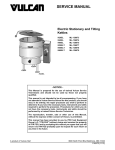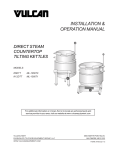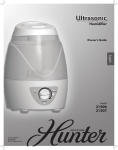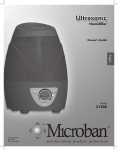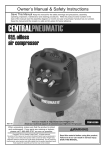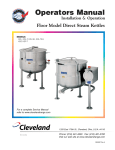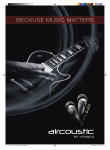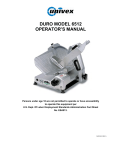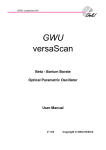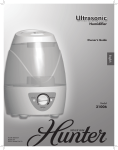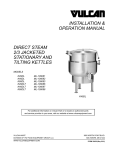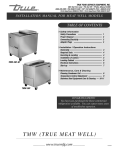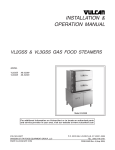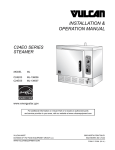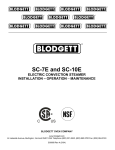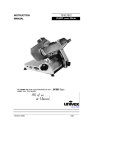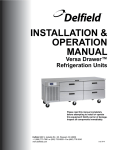Download Invacare 65400 Mobility Aid User Manual
Transcript
INSTALLATION & OPERATION MANUAL ELECTRIC STATIONARY AND TILTING KETTLES MODEL 30 60 90 120 0 30 Hg vac 150 psi MIL K20EL 136073 K40EL 136074 K60EL 136075 K20ETL 136077 K40ELT 136078 K60ELT 136079 K40EL For additional information on Vulcan-Hart or to locate an authorized parts and service provider in your area, visit our website at www.vulcanhart.com VULCAN-HART DIVISION OF ITW FOOD EQUIPMENT GROUP, LLC WWW.VULCANHART.COM 3600 NORTH POINT BLVD. BALTIMORE, MD 21222 FORM 35457 (10-09) ELECTRIC STATIONARY KETTLES IMPORTANT FOR YOUR SAFETY THIS MANUAL HAS BEEN PREPARED FOR PERSONNEL QUALIFIED TO INSTALL ELECTRICAL EQUIPMENT, WHO SHOULD PERFORM THE INITIAL FIELD START-UP AND ADJUSTMENTS OF THE EQUIPMENT COVERED BY THIS MANUAL. : Improper installation, adjustment, alteration, service or maintenance can cause property damage, injury or death. Read the INSTALLATION, OPERATION and MAINTENANCE instructions thoroughly before installing or servicing this equipment. —2— ELECTRIC STATIONARY KETTLES CONTENTS IMPORTANT FOR YOUR SAFETY ................................................................................................ 2 INSTALLATION, OPERATION AND MAINTENANCE OF K20EL/ELT, K40EL/ELT AND K60EL/ELT ELECTRIC KETTLES ......................................... 4 GENERAL ................................................................................................................................... 4 MODEL CHART ......................................................................................................................... 4 DATA PLATE LOCATION .......................................................................................................... 4 INSTALLATION ................................................................................................................................. 5 UNPACKING ............................................................................................................................... 5 INSTALLATION CODES AND STANDARDS ........................................................................... 5 LOCATION .................................................................................................................................. 5 Stationary Kettle ................................................................................................................... 5 Tilting Kettle .......................................................................................................................... 5 MINIMUM CLEARANCE REQUIREMENTS and RECOMMENDED FLOOR DRAIN LOCATIONS ..................................................................... 6 INSTALLATION PROCEDURE ................................................................................................. 6 Electrical Connection ........................................................................................................... 6 Electrical Specifications ...................................................................................................... 6 OPERATION .................................................................................................................................... 8 VENTING ..................................................................................................................................... 8 RESERVOIR JACKET WATER LEVEL CHECK ..................................................................... 8 DAILY OPERATION ................................................................................................................... 8 TILTING KETTLES ..................................................................................................................... 8 CONTROLS AND INDICATORS ............................................................................................... 8 CLEANING ........................................................................................................................................ 9 2" & 3" COMPRESSION VALVE CLEANING INSTRUCTIONS ............................................... 9 PLUG VALVE CLEAINING INSTRUCTIONS ........................................................................... 10 STAINLESS STEEL EQUIPMENT CARE AND CLEANING ................................................... 11 MAINTENANCE ............................................................................................................................. 13 VENTING .................................................................................................................................. 13 FILLING THE RESERVOIR JACKET ..................................................................................... 13 TROUBLESHOOTING .................................................................................................................. 14 SERVICE AND PARTS INFORMATION ...................................................................................... 15 —3— ELECTRIC STATIONARY KETTLES INSTALLATION, OPERATION AND MAINTENANCE OF K20EL/ELT, K40EL/ELT AND K60EL/ELT ELECTRIC KETTLES DATA PLATE LOCATION SAVE THESE INSTRUCTIONS FOR FUTURE USE The data plate stating the model number, serial number and the electrical characteristics is located on the back of Control Panel. The National Board Data Plate is located on the lower skirt. GENERAL Vulcan Steam Jacketed Kettles are produced with quality workmanship and material. Proper installation, usage and maintenance will result in many years of satisfactory performance. It is suggested that you thoroughly read this entire manual and carefully follow all of the instructions provided. MODEL CHART Model Gallons Quarts Liters K20EL, K20ELT 20 80 76 K40EL, K40ELT 40 160 152 K60EL, K60ELT 60 240 227 Fig. 2 Data Plate Location Fig. 1 Typical Stationary Kettle —4— ELECTRIC STATIONARY KETTLES INSTALLATION UNPACKING LOCATION This kettle was inspected before leaving the factory. The transportation company assumes full responsibility for safe delivery upon acceptance of the shipment. Stationary Kettle Position the kettle in its final location. Check that there are sufficient clearances for operating and servicing the kettle, and proper clearance of the cover when raised. The kettle draw-off valve should be located near a floor drain. Immediately after unpacking, check for possible shipping damage. If kettle damage is found, save the packaging material and contract the carrier within 15 days of delivery. Tilting Kettle INSTALLATION CODES AND STANDARDS Position the kettle in its final installed location to provide drainage directly below pour path, with sufficient rear clearance from the wall to allow the kettle to tilt completely without obstruction. In the United States, Vulcan kettles must be installed in accordance with: 1. State and local codes 2. NFPA Standard NFPA-96, Vapor Removal from Cooking Equipment, latest edition, available from the National Fire Protection Association, Batterymarch Park, Quincy, MA 02269 3. National Electrical Code (ANSI/NFPA No.70, latest edition) available from the National Fire Protection Association (NFPA), Batterymarch Park, Quincy, MA 02269 In Canada, Vulcan kettles must be installed in accordance with: 1. Local codes 2. Canadian Electrical Code (CSA C22.2 No.3, latest edition) available from the Canadian Standards Association, 5060 Spectrum Way, Mississauga, Ontario, Canada L4W 5N6 —5— ELECTRIC STATIONARY KETTLES MINIMUM CLEARANCE REQUIREMENTS AND RECOMMENDED FLOOR DRAIN LOCATIONS INSTALLATION PROCEDURE Level the kettle by making necessary adjustments using the flanged feet. No side and back clearance required, except for operation and service requirements. 1. Place a spirit level on the rim of the kettle with the cover open. Adjust the feet to level the kettle left-to-right and front-to-back. 2. Mark anchoring hole locations through the flanged feet. 3. With hole location marked, drill holes to accommodate 5/16" studs. 4. Reposition the kettle. 5. Bolt the kettle down and apply an NSF approved silicone sealant around the bolt heads and flange making contact with floor surface. Wipe off excess sealant immediately. Fig 3. Floor Drain Location —6— ELECTRIC STATIONARY KETTLES ELECTRICAL CONNECTION : Electrical and grounding connections must comply with applicable portions of the National Electric Code and/or other local electrical codes. Disconnect electrical power to the machine and follow Lockout/ Tagout procedures. 1. Open the control box. 2. Using the wiring diagram for reference, connect electric supply to terminal block. ELECTRICAL SPECIFICATIONS Amperage per Line MODEL K20EL/ELT kW 12 16 PHASE Minimum Circuit Ampacity 208V 240V 480V 208V 240V 480V 1 57.7 – – 75 – – 3 33.3 – 14.4 45 – 20 1 – 66.7 – – 85 – 3 – 38.5 – – 50 – K40EL/ELT K60EL/ELT 18 3 50.0 43.3 21.7 65 55 30 K40EL/ELT K60EL/ELT 24 3 66.6 57.7 28.9 85 75 40 K60EL/ELT 33 3 91.6 79.4 39.7 115 100 50 —7— ELECTRIC STATIONARY KETTLES OPERATION : The kettle and its parts are hot. Use care when operating, cleaning or servicing the kettle. 30 60 90 120 0 30 Hg vac 150 psi VENTING While the kettle is cold, check the vacuum/pressure gauge. The gauge should be in the vacuum zone measuring between 20 to 30 in. Hg (84 to 100kPa). If not, there is air in the jacket and it must be removed by venting for proper heating. Perform the VENTING procedure located in the MAINTENANCE section of this manual. RESERVOIR JACKET WATER LEVEL CHECK During use, the reservoir water level must be maintained high enough to submerge the heating elements. If the low water light is illuminated during use, perform the FILLING THE RESERVOIR JACKET procedure located in the MAINTENANCE section of this manual. Fig. 4 Kettle Controls CONTROLS AND INDICATORS DAILY OPERATION 1. Press the power switch to the ON position. 2. Preheat the kettle by placing the thermostat knob at Simmer/Boil (desired setting) and wait until the temperature light cycles off. Food products with milk or egg base should be placed into a cold kettle before cooking. Avoid sudden contact of these food products to a hot kettle surface because they stick to the surface. CONTROL FUNCTION Vacuum Pressure Gauge Indicates the vacuum (in inches) and pressure ( in PSI) inside the kettle jacket. Thermostat Knob Regulates kettle temperature from warm to a rolling boil. Low Water Indicator (Red) When lit, indicates insufficient water in the kettle jacket and the sensing probe has interrupted power supply to the controls and to the heating element. 3. Pour the food to be cooked into the kettle. Power ON/OFF Controls power to the kettle. Switch TILTING KETTLES The low water indicator light (red) should not be lit when kettle is in upright position during operation. This light indicates that the elements have been automatically shut off by the kettle’s safety circuity. It is, however, normal for the low water light (red light) to come on when the kettle is in a tilited posistion. —8— Power ON Indicator (Amber) When lit, indicates machine on/powered. Heater Light (Amber) When lit, indicates the heating element is turned on. ELECTRIC STATIONARY KETTLES CLEANING : The kettle and its parts are hot. Use care when operating, cleaning or servicing the kettle. 2. Thread the valve stem into bonnet till valve can be pulled through bonnet. NOTICE: 4. Install large nut hand tight. 3. Insert assembly into valve body. Never spray the exterior of the kettle or control box with water under any condition. Failure to comply will void the warranty. 5. Install valve handle, lock washer and nut onto the valve stem. 6. Turn valve handle clockwise until closed. Do not overtighten. The kettle interior and exterior should be thoroughly washed after each use when a different food is to be cooked next or when cooking is completed for the day. Daily After Use Remove draw-off valve stem assembly for cleaning. 1. Add water to the kettle for cleaning and to prevent residue from drying and sticking to the inside of the kettle. 1. Turn the valve handle counterclockwise until it stops. 2. Loosen stuck-on food by allowing it to soak at a low temperature setting. 2. Pull the valve handle back until it stops. 3. Turn large bonnet retaining nut counterclockwise until the valve stem assembly is loose. Never use harsh or corrosive cleaning chemicals. Never scrape the inside of the kettle with abrasive cleansers, metal tools or steel scouring pads, which will scratch the surface, spoil the appearance and make it more difficult to thoroughly clean. 4. Pull the assembly straight out of the valve body. 5. Remove the stem from the bonnet. 6. Wash valve body and steam assembly with mild soap and water. 3. Add mild detergent and scrub the kettle interior with a nylon brush. 7. Leave assembly apart to air dry. 4. Thoroughly rinse the interior and dry with a soft cloth. 5. Rinse the exterior and dry with a soft cloth. 2" & 3" COMPRESSION VALVE CLEANING INSTRUCTIONS Fig. 6 Compression Valve Daily Before Operation Install draw-off valve assembly: 1. Apply PetroGel lubricant to valve stem threads, “O” ring, rubber plug face and large nut threads. —9— ELECTRIC STATIONARY KETTLES PLUG VALVE CLEAINING INSTRUCTIONS NOTE: Daily Before Operation Install draw off valve plug: 1. Apply PetroGel lubricant to valve tapered face. 1. Care should be taken not to scratch, ding or dent the valve plug to prevent valve leakage. 2. If multiple kettles are in use care should be taken keep each plug separate and returned to its original valve body. 2. Holding the valve handle, slide the plug down into the valve body. 3. Install the bottom washer, making sure to align the key with the groove in the valve plug. 4. Install the retaining ring and hand tighten. Valve Plug NOTE: If the valve is hard to open the ring has been overtightened. Daily After Use Valve Body Remove draw-off valve plug for cleaning. 1. Unscrew the retaining ring and remove it and the bottom washer. 2. Pull the valve plug straight up to remove from valve body. Bottom Washer 3. Wash valve body, plug, washer and retaining ring with mild soap and water. Retaining Ring 4. Leave assembly apart to air dry. Fig. 7 Plug Valve — 10 — ELECTRIC STATIONARY KETTLES heated leave deposits behind that if left to sit, will break down the passive layer and rust stainless steel. Other deposits from food preparation and service must be properly removed. STAINLESS STEEL EQUIPMENT CARE AND CLEANING Contrary to popular belief, stainless steels ARE susceptible to rusting. Corrosion on metals is everywhere. It is recognized quickly on iron and steel as unsightly yellow/orange rust. Such metals are called “active” because they actively corrode in a natural environment when their atoms combine with oxygen to form rust. Stainless steels are passive metals because they contain other metals, like chromium, nickel and manganese that stabilize the atoms. 400 series stainless steels are called ferritic, contain chromium, and are magnetic; 300 series stainless steels are called austenitic, contain chromium and nickel; and 200 series stainless, also austenitic, contains manganese, nitrogen and carbon. Austenitic types of stainless are not magnetic, and generally provide greater resistance to corrosion than ferritic types. With 12-30 percent chromium, an invisible passive film covers the steel’s surface acting as a shield against corrosion. As long as the film is intact and not broken or contaminated, the metal is passive and stain-less. If the passive film of stainless steel has been broken, equipment starts to corrode. At its end, it rusts. Chlorides are found nearly everywhere. They are in water, food and table salt. One of the worst chloride perpetrators can come from household and industrial cleaners. So what does all this mean? Don’t Despair! Here are a few steps that can help prevent stainless steel rust. 1. Use the proper tools. When cleaning stainless steel products, use non-abrasive tools. Soft cloths and plastic scouring pads will not harm steel’s passive layer. Stainless steel pads also can be used but the scrubbing motion must be in the direction of the manufacturers’ polishing marks. 2. Clean with the polish lines Some stainless steel comes with visible polishing lines or “grain.” When visible lines are present, always scrub in a motion parallel to the lines. When the grain cannot be seen, play it safe and use a soft cloth or plastic scouring pad. 3. Use alkaline, alkaline chlorinated or non-chloride containing cleaners. While many traditional cleaners are loaded with chlorides, the industry is providing an ever-increasing choice of non-chloride cleaners. If you are not sure of chloride content in the cleaner used, contact your cleaner supplier. If your present cleaner contains chlorides, ask your supplier if they have an alternative. Avoid cleaners containing quaternary salts; it also can attack stainless steel and cause pitting and rusting. Enemies of Stainless Steel There are three basic things which can break down stainless steel’s passivity layer and allow corrosion to occur. 1. Mechanical abrasion 2. Deposits and water 3. Chlorides Mechanical abrasion means those things that will scratch a steel surface. Steel pads, wire brushes and scrapers are prime examples. 4. Treat your water. Water comes out of the faucet in varying degrees of hardness. Depending on what part of the country you live in, you may have hard or soft water. Hard water may leave spots, and when — 11 — Though this is not always practical, softening hard water can do much to reduce deposits. There are certain filters that can be installed to remove distasteful and corrosive elements. To insure proper water treatment, call a treatment specialist. ELECTRIC STATIONARY KETTLES 5. Keep your food equipment clean. 6. Rinse, rinse, rinse. Use alkaline, alkaline chlorinated or nonchloride cleaners at recommended strength. Clean frequently to avoid build-up of hard, stubborn stains. If you boil water in stainless steel equipment, remember the single most likely cause of damage is chlorides in the water. Heating cleaners that contain chlorides have a similar effect. If chlorinated cleaners are used, rinse and wipe equipment and supplies dry immediately. The sooner you wipe off standing water, especially when it contains cleaning agents, the better. After wiping equipment down, allow it to air dry; oxygen helps maintain the stainless steel’s passivity film. 7. Never use hydrochloric acid (muriatic acid) on stainless steel. 8. Regularly restore/passivate stainless steel. Recommended cleaners for specific situations JOB CLEANING AGENT COMMENTS Routine cleaning Soap, ammonia, detergent, Medallion Apply with cloth or sponge Fingerprints & smears Arcal 20, Lac-O-Nu Ecoshine Provides barrier film Stubborn stains & discoloration Cameo, Talc, Zud, First Impression Rub in direction of polish lines Grease & fatty acids, blood, burnt-on-foods Easy-off, De-Grease It Oven Aid Excellent removal on all finishes Grease & oil Any good commercial detergent Apply with sponge or cloth Restoration/Passivation Benefit, Super Sheen Review 1. Stainless steels rust when passivity (filmshield) breaks down as a result of scrapes, scratches, deposits and chlorides. 5. Soften your water. Use filters and softeners whenever possible. Stainless steel rust starts with pits and cracks. 6. Wipe off cleaning agent(s) and standing water as soon as possible. Prolonged contact causes eventual problems. 3. Use the proper tools. Do not use steel pads, wire brushes or scrapers to clean stainless steel. To learn more about chloride-stress corrosion and how to prevent it, contact the equipment manufacturer or cleaning materials supplier. 4. Use non-chlorinated cleaners at recommended concentrations. Use only chloride- free cleaners. Developed by Packer Engineering, Naperville, Ill., an independent testing laboratory. Provided courtesy of NAFEM. 2 — 12 — ELECTRIC STATIONARY KETTLES MAINTENANCE VENTING FILLING THE RESERVOIR JACKET The vacuum pressure gauge measuring zone should be between 20 to 30 in.Hg (84 to 100kPa). If the vacuum pressure is not within this range, perform the following: 2. Set the temperature control to the max heat setting. Let the kettle heat until it cycles off. Before adding water to the reservoir, the water supply should be analyzed to ensure that hardness is no greater than 2.0 grains per gallon and the pH level is within the range of 7.0 to 8.5. Water which fails to meet these standards should be treated, or use ionized distilled water with sodium. Equipment failure caused by inadequate water quality is not covered under warranty. To fill the reservoir jacket, perform the following: 3. Pull the pressure relieve valve D-ring to relieve pressure for 10 seconds. 1. Set the thermostat and power switch to OFF position. 4. Turn kettle off and let cool. Check for a correct vacuum pressure of 20 to 30 in. Hg (84 to 100kPa). If the reading is not correct, repeat steps 1 through 3. 2. Release any pressure by the O-ring on the pressure relief valve. Then remove the 1/2 " plug on the back of the kettle. 1. With the kettle empty, place the power switch to the ON position. 30 0 30 Hg vac 60 3. Insert a funnel into the fill valve and add 3 or 4 ounces of water. 4. Replace and properly tighten the 1/2" plug. 90 120 150 5. Turn on the kettle. psi 30 0 30 Hg vac 60 If the low water light turns on, turn off the unit and repeat steps 3 and 4. If low water light is off, follow the venting procedure (see VENTING) to vent air from reservoir. 90 120 150 psi MODEL Fig. 5 Rear of Kettle — 13 — TOTAL DISTILLED WATER REQUIREMENTS K20EL / K20ELT 1.25 gallons (4.1) K40EL / K40ELT 2.0 gallons (6.5) K60EL / K60ELT 2.1 gallons (7.4) ELECTRIC STATIONARY KETTLES TROUBLESHOOTING PROBLEM Unit not Heating POSSIBLE CAUSES / SUGGESTED CORRECTIVE ACTION ON/OFF switch OFF / ON/OFF switch ON. Thermostat not on / Turn thermostat on. No power / Check power supply. Water level too low / Add water. Malfunctioning power ON/OFF switch / Contact Authorized Vulcan-Hart Service Provider. Malfunctioning thermostat / Contact Authorized Vulcan-Hart Service Provider. Contactors not connecting heating element to power source / Contact Authorized Vulcan-Hart Service Provider. Unit not heating to desired temperature Thermostat not on / Turn thermostat on. Malfunctioning thermostat / Contact Authorized Vulcan-Hart Service Provider. Draw valve is leaking Check and clean any food residue with an extremely fine emery cloth. Replace the “O” ring. — 14 — ELECTRIC STATIONARY KETTLES SERVICE AND PARTS INFORMATION To obtain service and parts information concerning this unit, contact the Vulcan-Hart Service Agency in your area (refer to listing supplied with the steamer), or contact the Vulcan-Hart Service Department at the address or phone number shown on the front cover of this manual. Parts and service are also available at www.vulcanhart.com. — 15 — ELECTRIC STATIONARY KETTLES (10-09) — 16 — PRINTED IN U.S.A.
















